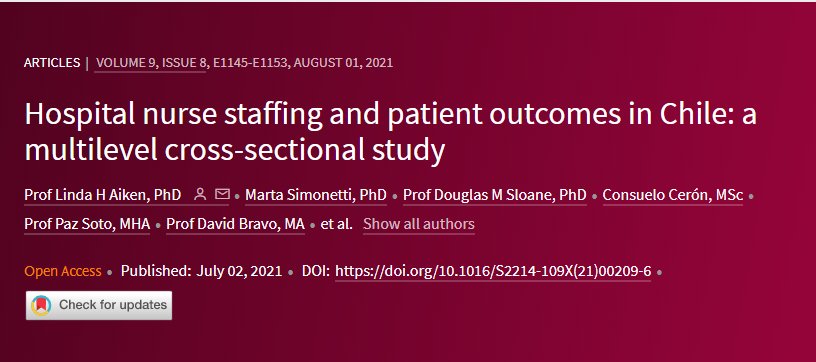患者|Lancet Global Health:智利医院护士人力配备和患者结局

文章插图
Abstract
Background
Unrest in Chile over inequalities has underscored the need to improve public hospitals. Nursing has been overlooked as a solution to quality and access concerns, and nurse staffing is poor by international standards. Using Chile's new diagnosis-related groups system and surveys of nurses and patients, we provide information to policy makers on feasibility, net costs, and estimated improved outcomes associated with increasing nursing resources in public hospitals.
Methods
For this multilevel cross-sectional study, we used data from surveys of hospital nurses to measure staffing and work environments in public and private Chilean adult high-complexity hospitals, which were linked with patient satisfaction survey and discharge data from the national diagnosis-related groups database for inpatients. All adult patients on medical and surgical units whose conditions permitted and who had been hospitalised for more than 48 h were invited to participate in the patient experience survey until 50 responses were obtained in each hospital. We estimated associations between nurse staffing and work environment quality with inpatient 30-day mortality, 30-day readmission, length of stay (LOS), patient experience, and care quality using multilevel random-effects logistic regression models and zero-truncated negative binomial regression models, with clustering of patients within hospitals.
Findings
【患者|Lancet Global Health:智利医院护士人力配备和患者结局】 We collected and analysed surveys of 1652 hospital nurses from 40 hospitals (34 public and six private), satisfaction surveys of 2013 patients, and discharge data for 761 948 inpatients. Nurse staffing was significantly related to all outcomes, including mortality, after adjusting for patient characteristics, and the work environment was related to patient experience and nurses' quality assessments. Each patient added to nurses' workloads increased mortality (odds ratio 1·04, 95% CI 1·01–1·07, p<0·01), readmissions (1·02, 1·01–1·03, p<0·01), and LOS (incident rate ratio 1·04, 95% CI 1·01–1·06, p<0·05). Nurse workloads across hospitals varied from six to 24 patients per nurse. Patients in hospitals with 18 patients per nurse, compared with those in hospitals with eight patients per nurse, had 41% higher odds of dying, 20% higher odds of being readmitted, 41% higher odds of staying longer, and 68% lower odds of rating their hospital highly. We estimated that savings from reduced readmissions and shorter stays would exceed the costs of adding nurses by US$1·2 million and $5·4 million if the additional nurses resulted in average workloads of 12 or ten patients per nurse, respectively.
Interpretation
Improved hospital nurse staffing in Chile was associated with lower inpatient mortality, higher patient satisfaction, fewer readmissions, and shorter hospital stays, suggesting that greater investments in nurses could return higher quality of care and greater value.
摘要翻译(仅供参考)
背景
智利因不平等引起的动荡凸显了改善公立医院的必要性。护理作为解决质量和可及性问题的解决方案而被忽视,而且按照国际标准,护士人员配置很差。使用智利新的诊断相关团体系统和护士和患者调查,我们向决策者提供有关可行性、净成本和与增加公立医院护理资源相关的估计改善结果的信息。
方法
在这项多级横断面研究中,我们使用医院护士调查的数据来衡量智利公立和私立成人高复杂性医院的人员配备和工作环境,这些数据与患者满意度调查和国家诊断相关组的出院数据相关联住院病人数据库。邀请所有条件允许且住院时间超过 48 小时的内科和外科病房成年患者参与患者体验调查,直至每家医院获得 50 份答复。我们使用多级随机效应逻辑回归模型和零截断负二项式回归估计了护士人员配备和工作环境质量与住院患者 30 天死亡率、30 天再入院率、住院时间 (LOS)、患者体验和护理质量之间的关联模型,将医院内的患者聚集在一起。
推荐阅读
- 大学附属医院|为慢性病患者服务 南京医科大学大学生社会实践课走进社区
- 一等奖|泸州开放大学学生景秋宇在国家开放大学 第二届“学习进取、服务患者”护理病例大赛中获得一等奖
- UCSF 护理学院|癌症患者在 COVID 期间孤独和沮丧 | 癌症
- 医学生|大二医学生为患者做手术,还未取得医师资格证
- 运营|University of Bristol MSc Global Operations and Supply Chain Management
- 郑州|郑州:15名新冠肺炎患者为同校小学生
- 郑州市|郑州15名新冠肺炎患者为同校小学生,1名舞蹈老师确诊
- China continues to contribute to global economic security, sustainable development
- 学霸|升入初中后“学霸”变“学渣”!这家医院半天接诊53个患者
- finChina shares achievements with world for global economic recovery











